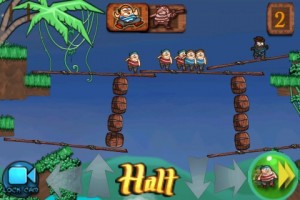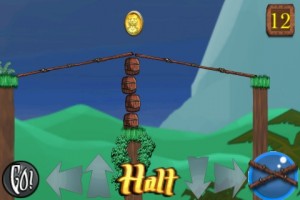(Editor’s Note: What follows is the original review written for the first version the author played. Since then, one or more major critiques have been addressed by the developer. For a list of these, see “Addendums” below the original review score at the end of the article.)
A pirate expedition has landed on an island where gold flows aplenty! Solid footing, on the other hand, is at a premium. The crew needs someone to help them Bridge the Gap (Out Now, $0.99) using the many poles and barrels they’ve handily brought along for their journey.
 The player’s job here is to lay down barrels and poles so they form crude suspension bridges over gorges that lie between the pirate crew and the end of each level. While the crew patiently sits still – eternally grumbling “Arr!” and “Yo ho ho!” as pirates often do – the player goes about the major portion of his or her task, taking care that the bridges are both functional and structured to let them reach floating gold coins once they’re allowed to march. As one would expect this gets quite interesting, requiring a clever approach for handling jagged landmasses and frighteningly wide ravines. Efficiency is critical, as the player has only so much timber on hand to work with.
The player’s job here is to lay down barrels and poles so they form crude suspension bridges over gorges that lie between the pirate crew and the end of each level. While the crew patiently sits still – eternally grumbling “Arr!” and “Yo ho ho!” as pirates often do – the player goes about the major portion of his or her task, taking care that the bridges are both functional and structured to let them reach floating gold coins once they’re allowed to march. As one would expect this gets quite interesting, requiring a clever approach for handling jagged landmasses and frighteningly wide ravines. Efficiency is critical, as the player has only so much timber on hand to work with.
That’s not to say the player’s job ends once the bridges are placed — far from it. With a tap at a virtual button the pirates dutifully march forth to test the player’s handiwork, and the player can tap on individual crew members to make them jump over rough corners so they don’t accidentally shove structural pieces out of the way. Armed natives aren’t exactly pleased about all the plundering happening in their territory, so the player may have to switch the pirates from jumping mode to shooting mode and let loose a few pistol shots. The potential for fisticuffs has to be taken into account during the building phase, because bullets are perfectly capable of knocking down structural elements on their own.
Bridge the Gap has a thoroughly engaging premise going for it, and the game’s carefully calibrated level design demands a satisfying amount of critical thinking on the player’s part. Unfortunately it’s weighed down by a number of issues at release. The hardest to address in updates, no doubt, will be its use of a complex interface in a genre where players aren’t so accustomed to this. Spread along the bottom of the touchscreen are virtual buttons for shifting the player’s view and one that must be tapped to cycle through pole laying, barrel dropping, and removal modes during the building phase.
 Virtual buttons cluttering the bottom edge of the touchscreen defeat the player’s ability to recover misplaced structural elements with unseemly frequency. If a pole or tower of barrels becomes unsteady, chances are it will spill right into the drink, where the player can’t tap to recover it because the interface is sitting right on top of the lost resource. The amount of lumber available to the player seems calibrated to fit a perfect solution almost exactly sometimes, so a single accident might force a retreat into the pause menu for purposes of starting over. I can’t shake the feeling that implementing swipe-to-pan and a drag-and-drop interface for laying down bridges would free up precious touchscreen area and dramatically improve the player’s experience.
Virtual buttons cluttering the bottom edge of the touchscreen defeat the player’s ability to recover misplaced structural elements with unseemly frequency. If a pole or tower of barrels becomes unsteady, chances are it will spill right into the drink, where the player can’t tap to recover it because the interface is sitting right on top of the lost resource. The amount of lumber available to the player seems calibrated to fit a perfect solution almost exactly sometimes, so a single accident might force a retreat into the pause menu for purposes of starting over. I can’t shake the feeling that implementing swipe-to-pan and a drag-and-drop interface for laying down bridges would free up precious touchscreen area and dramatically improve the player’s experience.
Additional complaints are comparatively minor. Should all the pirates slip into their watery graves or otherwise find themselves stuck with no way to progress, the game continues running normally until the player manually resets the level. Tapping on barrels and poles also feels spotty at present, as if these objects could use some widening of their touch-sensitive response areas. The highlight of Bridge the Gap‘s interface is a fast-forward button for making the pirates pick up the pace once they start moseying along, which is much appreciated!
Bridge the Gap‘s hand-drawn sprites may be diminutive and relatively limited in animation, but they still have plenty of character. The game’s music is really catchy, which makes it such a shame that it completely cuts out once the player switches from building to walking mode! The groovy soundtrack gets washed out by a crunchy wave-cresting noise once the player hits that “Go!” button.
Weighing in at 25 levels with more on the way, Bridge the Gap should be good for three hours of logistics-based entertainment, factoring in retries.
iFanzine Verdict: Bridge the Gap could benefit immensely from further polishing, and screams for it in the interface department at least. That said, it’s got such heart and soul that it’s worth a go for logic puzzle and physics puzzle fans who are willing to dig through some flaws in search of well-devised challenge.
Addendum: New user interface

